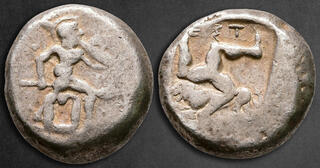| Savoca Numismatik GmbH & Co. KG > Online Auction 209 | Silver | Auction date: 28 April 2024 |
| Lot number: 141 Price realized: 260 EUR (Approx. 279 USD) Note: Prices do not include buyer's fees. | Show similar lots on CoinArchives Find similar lots in upcoming auctions on |
| Lot description: Pamphylia. Aspendos circa 460-430 BC. Stater AR 20 mm, 10,78 g Helmeted, nude hoplite advancing to right, holding shield and spear; superimposed astragalos shape contained within raised edges beneath legs / Triskeles, EΣT above; below, lion standing to left; all within incuse square. Very Fine Cf. Roma E-52, lot 313; SNG Copenhagen -; SNG BnF -; SNG von Aulock; - Traité -; for rev. type cf. SNG BnF 13. Ex Roma Numismatics, E-Sale 93, Lot 529. The triskeles is a symbol consisting of three interlocked spirals or legs, forming a motif resembling three bent human legs or three interconnected spirals. This symbol has been used in various cultures throughout history and holds different meanings depending on the context. In ancient Greek culture, the triskeles was associated with various deities and concepts. It was often used as a symbol of motion, progress, and dynamic action. In some cases, it was linked to the goddess Hecate, who was associated with crossroads, transitions, and transformation. The three legs of the triskeles were sometimes interpreted as representing the three phases of the moon or the three realms of the world: earth, sea, and sky. On ancient coins, the triskeles motif may appear in different forms and variations, depending on the region and time period. It could be depicted as a simple geometric design or as a more elaborate and stylized symbol. The presence of the triskeles on a coin may indicate the cultural and religious beliefs of the issuing authority, as well as its connection to broader mythological and symbolic traditions. Starting price: 100 EUR |  |


